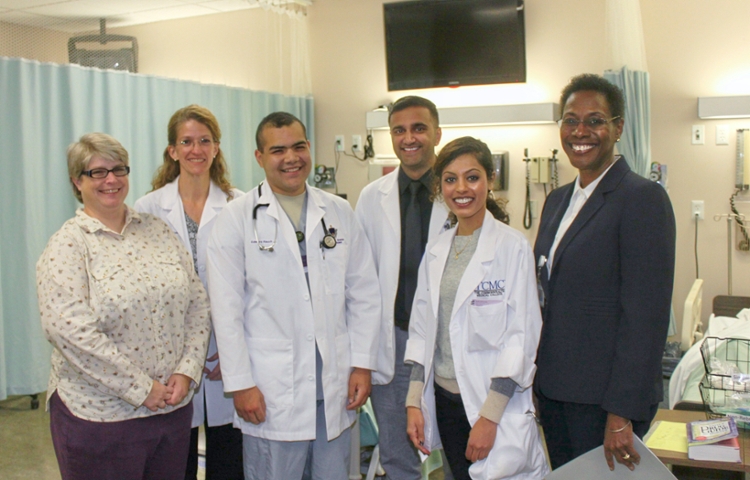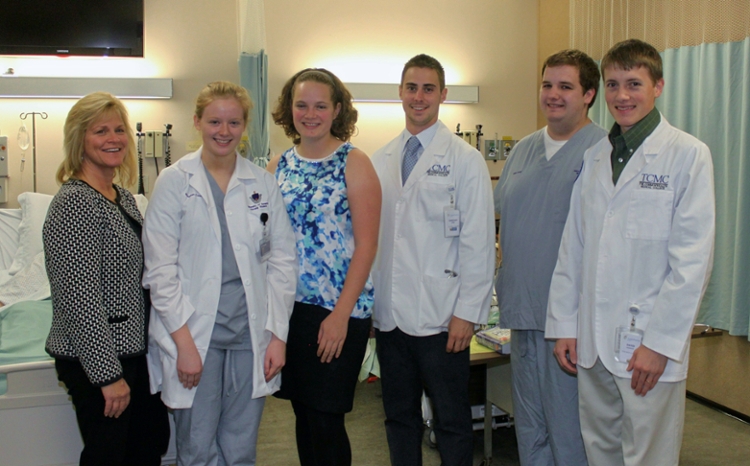Teamwork is Key Goal of Interprofessional Simulation

Nursing students at The University of Scranton, social-work graduate students at Marywood University and medical students at TCMC participated in an interprofessional simulation using SimMan, an advanced patient simulator. From left: Lea Dougherty, instructor, Marywood University, School of Social Work; Janet Kobrick, University of Scranton senior majoring in nursing, Eynon; Edward Rauch, University of Scranton senior majoring in nursing, Clinton, New Jersey; Ravi Parekh, TCMC, third-year medical student, Richmond, Virginia; Megha Patel, TCMC, third-year medical student, Drums; Diana Callender, TCMC, interim chair of clinical sciences.

More than 150 students from The University of Scranton, Marywood University and TCMC participated in an interprofessional simulation on the campuses of TCMC and Scranton. From left: Wendy Manetti, University of Scranton faculty specialist, Department of Nursing; Meghan Connelly, University of Scranton junior majoring in nursing, Somerset, New Jersey; Melissa Fuchs, Marywood University, social-work graduate student, Germantown, New York; Gregory Jones, TCMC, third-year medical student, Pittsburgh; Brian Dolan, University of Scranton senior majoring in nursing, Pearl River, New York; David Johnson, TCMC, third-year medical student, Williamsport.
You can lead a patient to a medical examination table, but you can’t make him wheeze – nor can you force his blood pressure to drop or his pulse to slow.
That’s the beauty of SimMan, an advanced patient simulator that recently gave nursing students at The University of Scranton, social-work students at Marywood University and future doctors at The Commonwealth Medical College (TCMC) some real-life lessons in handling rapidly declining patients. It also taught the students the value of interprofessional teamwork.
SimMan, in this case, was a 16-year-old boy suffering from an advanced case of asthma exacerbated by family challenges such as lack of health insurance. His parents were immigrants of several years ago, explained Deborah Zielinski, director of the nursing laboratory and clinical coordinator at the University.
The two standardized actors who played the boy’s mom and dad outlined the financial and other serial problems that prevented them from keeping on top of their son’s treatment. The lack of insurance, for example, meant he had not been using his nebulizer because they were unable to pay for it. They also had another child at home with special needs.
Those issues were first explained to the six Marywood social-work graduate students involved in the simulation, who passed along the critical information to the nursing students to aid their initial assessments.
Learning the patient’s backstory helped student nurses better understand a course of action for their patient, said Colleen Oggeri, a senior at The University of Scranton from Merrick, N.Y. Knowing ahead of time that her patient was going to enter a rapid-response state, she said, it was clear to her that she had to “get the doctor pretty quickly.”
This was a high-fidelity simulation, which permits a changing and escalating situation, explained Margarete Zalon, Ph.D., who helped organized the challenging smulation, which involved about 150 students across the three campuses.
“The mannequins, which are programmed by the laboratory staff, respond physiologically to student interventions such as the administration of oxygen or a nebulizer treatment,” she said.
Giving the students the opportunity to think critically while working together is crucial, Dr. Zalon said, citing research data that show collaboration among healthcare professionals produces better outcomes.
“Many times students don’t see an emergent situation in their learning,” she said, and are therefore not highly exposed to its consequences. “Here you can do things (such as control heart rate) that allow the students to have that realistic experience.”
In these simulations – of which there were 18 over two days for a total of 36 – students were presented with the situation and given a few minutes to talk to one another about their roles before working together to manage the care of the declining patient.
Some simulations were conducted at the University and some at The Commonwealth Medical College. Both schools have high-fidelity simulators.
The planning for the simulations also was collaborative, Dr. Zalon added, noting it began as a result of a pilot study 20 months ago. That pilot study, performed at TCMC by a much smaller group but deemed successful, had to be transformed so it could be replicated 36 times, she said. The transformation focused on critical elements and employed key principles of TeamSTEPPS™, an evidence-based program developed by the Department of Defense and Agency for Healthcare Research and Quality that health care organizations use to help people work together.
Faculty and staff at the University’s Nursing Department participating in the planning, and/or debriefing included Wendy Manetti, faculty specialist; Kimberly Subasic, Ph.D., assistant professor; Catherine Lovecchio, Ph.D., associate professor; Linda Lewis, faculty specialist; Annette Tross, faculty specialist; Cristen Walker, faculty specialist; Elena Sanfilippo, adjunct professor; Richelle Stephens, laboratory instructor; Colleen Heckman, assistant director of nursing lab; and Laura Skoronski, nursing lab supervisor and educator.
Following each simulation were the equally important debriefings, in which faculty members from the University, TCMC and Marywood spent time with the students focusing largely on how the teamwork went in addressing patient needs, she said.
That focus goes back at least 10 years, Dr. Zalon said, to when The Institute of Medicine, an independent advisory organization that is the health arm of the National Academy of Sciences, issued a report about competencies which all healthcare professionals need to have. Collaboration and teamwork were high on that list.






